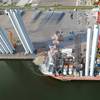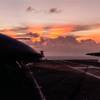Regulations for the Prevention of Air Pollution from Ships are set to enter into force on 19 May 2005, following the ratification by the Independent State of Samoa of Annex VI of the International Convention for the Prevention of Pollution from Ships, 1973, as modified by the Protocol of 1978 relating thereto (MARPOL 73/78).
The 1997 Protocol to the MARPOL Convention, which includes Annex VI, enters into force 12 months after being accepted by 15 States with not less than 50% of world merchant shipping tonnage. Samoa, the fifteenth State to ratify the instrument, deposited its ratification on 18 May 2004. Annex VI has now been ratified by States with 54.57% of world merchant shipping tonnage.
Annex VI sets limits on sulphur oxide and nitrogen oxide emissions from ship exhausts and prohibits deliberate emissions of ozone-depleting substances.
IMO Secretary-General Efthimios E. Mitropoulos said he was pleased to see the Annex achieve sufficient ratifications to enter into force.
"With the entry into force of Annex VI, the full set of MARPOL international regulations for the prevention of pollution by ships will be in force. We must now ensure their effective implementation and enforcement", he said.
In welcoming entry into force of Annex VI, the Secretary-General also took the opportunity to urge Governments to ratify other IMO pollution-prevention instruments, particularly the International Convention on the Control of Harmful Anti-fouling Systems on Ships of 2001, which has so far been ratified by eight of the 25 States representing 25% of the world's tonnage required for it to enter into force, and the recently adopted International Convention for the Control and Management of Ships' Ballast Water and Sediments.
Regulations on Prevention of Air Pollution from ships
The Protocol including Annex VI to the MARPOL Convention was adopted at a Conference held in September 1997, in response to IMO Assembly Resolution A.719(17) on Prevention of Air Pollution from Ships, adopted in 1991, which called on IMO's Marine Environment Protection Committee (MEPC) to prepare a new draft Annex to MARPOL 73/78 on prevention of air pollution. The Annex was developed over the next few years.
The regulations include a global cap of 4.5% m/m on the sulphur content of fuel oil and calls on IMO to monitor the worldwide average sulphur content of fuel once the Protocol comes into force.
Annex VI contains provisions allowing for special "SOx Emission Control Areas" to be established with more stringent controls on sulphur emissions. In these areas, the sulphur content of fuel oil used on board ships must not exceed 1.5% m/m. Alternatively, ships must fit an exhaust gas cleaning system or use any other technological method to limit SOx emissions. The Baltic Sea Area is designated as a SOx Emission Control area in the Protocol.
In March 2000, the MEPC approved a proposed amendment to Annex VI to also include the North Sea as a SOx Emission Control Area. The aim is to adopt the amendment once MARPOL Annex VI enters into force.
Annex VI prohibits deliberate emissions of ozone depleting substances, which include halons and chlorofluorocarbons (CFCs). New installations containing ozone-depleting substances are prohibited on all ships. But new installations containing hydro-chlorofluorocarbons (HCFCs) are permitted until 1 January 2020.
Annex VI also sets limits on emissions of nitrogen oxides (NOx) from diesel engines. A mandatory NOx Technical Code, which defines how this shall be done, was adopted by the Conference under the cover of Resolution 2.
The Annex also prohibits the incineration on board ships of certain products, such as contaminated packaging materials and polychlorinated biphenyls (PCBs).
Greenhouse gas emissions
As Annex VI does not cover the emission of greenhouse gases from ships, the IMO Assembly in November 2003 adopted resolution A.963(23) on IMO Policies and Practices related to the Reduction of Greenhouse Gas Emissions from Ships.
Featured videos

Inmarsat Enhances Service to Drive Digitalization

Inside the Electrified Truckable Tug

Tracking Foreign Vessels Working in the U.S. Jones Act Market
Subscribe for
Maritime Reporter E-News
Maritime Reporter E-News is the maritime industry's largest circulation and most authoritative ENews Service, delivered to your Email five times per week









